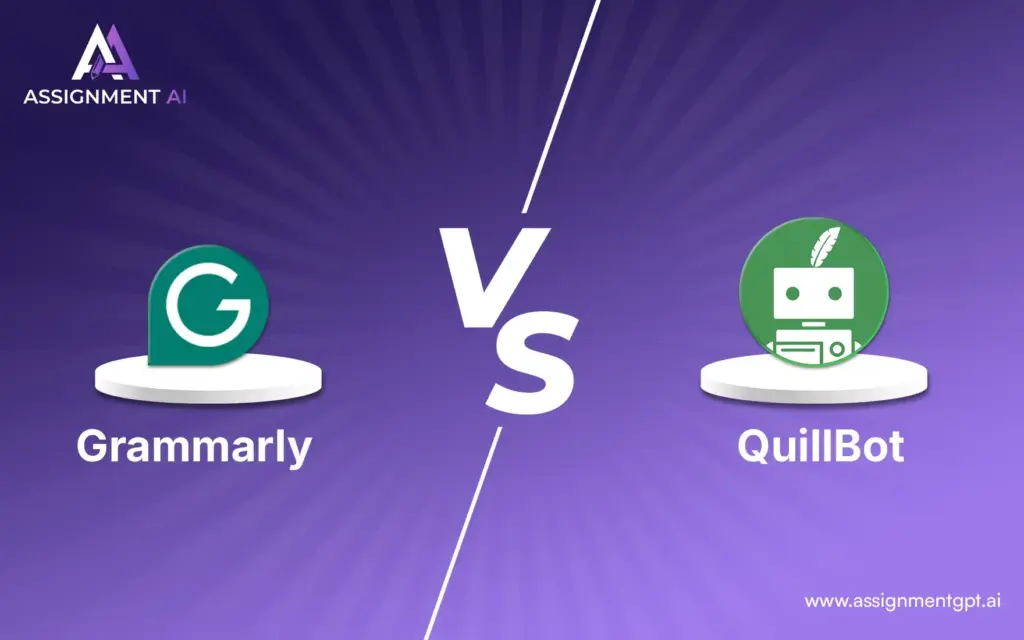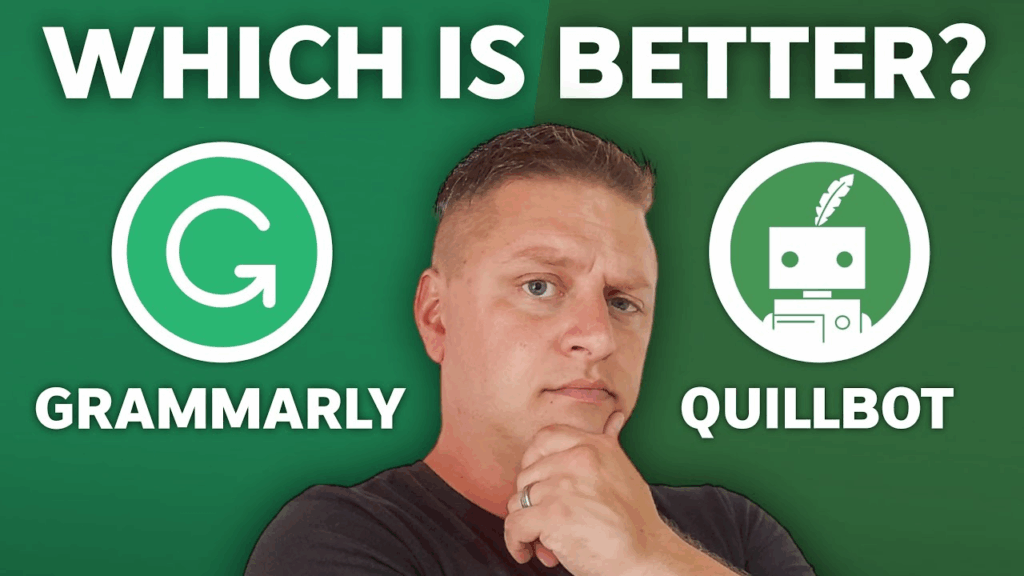Good writing is an essential skill for students in 2025. Whether it’s writing essays, preparing research papers, or crafting professional emails, the ability to communicate clearly has a direct impact on academic and career success. With technology advancing rapidly, students now have access to AI-powered tools that make writing easier and more accurate. Two of the most popular writing tools today are Grammarly and QuillBot. Both platforms are widely used by students around the world, but the big question is: which one is better for students? In this article, we will explore Grammarly and QuillBot in detail, comparing their features, pros, cons, and practical use cases to help students decide which tool fits their needs best.

Overview of Grammarly
Grammarly is a powerful writing assistant that checks grammar, punctuation, spelling, and style. Beyond simple corrections, it helps users improve clarity, engagement, and tone. For students, Grammarly is like having a virtual writing coach who not only corrects mistakes but also explains them. A student writing a literature essay, for example, might struggle with comma placement and sentence clarity. Grammarly instantly highlights the issue, provides suggestions, and explains why a change is needed. Over time, this builds stronger writing habits. Grammarly’s browser extension, desktop app, and mobile keyboard make it accessible anywhere, from drafting an essay on a laptop to sending an email from a smartphone.
Overview of QuillBot
QuillBot is best known as a paraphrasing and rephrasing tool, but it has grown into a full-fledged writing assistant. It allows students to rewrite sentences, summarize articles, check grammar, and even cite sources. For students who often face plagiarism concerns or need help simplifying complex text, QuillBot is a lifesaver. Imagine a student struggling to reword a scientific explanation for a research project. QuillBot can generate multiple rephrased versions, making it easier to maintain originality while keeping the meaning intact. The platform also offers modes like Formal, Simple, and Creative, giving students flexibility depending on the type of writing.

Feature Comparison
1. Grammar and Spelling Check
Grammarly is highly advanced in grammar and spelling detection. It not only identifies basic mistakes but also suggests stylistic improvements. For example, it can flag passive voice or overly complex sentences. QuillBot includes a grammar checker too, but it is not as sophisticated as Grammarly’s engine. For detailed grammar corrections, Grammarly takes the lead.
2. Paraphrasing and Rewriting
This is where QuillBot shines. It offers multiple modes of paraphrasing, from shortening text to making it more creative. For students rewriting research or avoiding accidental plagiarism, QuillBot is incredibly useful. Grammarly does not focus on paraphrasing, so QuillBot dominates this category.
3. Plagiarism Detection
Grammarly’s premium version includes a plagiarism checker that scans billions of web pages and academic databases. This is vital for students submitting essays or research papers. QuillBot, while excellent for paraphrasing, does not provide plagiarism detection in the free version. Students often combine both tools: QuillBot to rewrite, Grammarly to check plagiarism.
4. Writing Suggestions and Tone
Grammarly goes beyond corrections and provides suggestions on clarity, tone, and word choice. If a student writes, “The results are not good,” Grammarly might suggest “The results are unsatisfactory” for a more formal academic tone. QuillBot focuses more on restructuring text rather than improving tone.
5. Summarizing Capabilities
QuillBot includes a summarizer that condenses long articles or essays into shorter versions. This is perfect for students preparing for exams or doing quick research. Grammarly does not offer a summarization feature, so QuillBot wins in this category.
6. Ease of Use and Accessibility
Grammarly is extremely user-friendly, with apps, browser extensions, and integrations with platforms like Microsoft Word. QuillBot, while also simple to use, mainly functions as a web app. Both are accessible, but Grammarly integrates more deeply into daily student workflows.
7. Pricing
Both Grammarly and QuillBot offer free versions, but their premium plans differ. Grammarly Premium costs around $12 per month and includes advanced grammar checks, tone detection, and plagiarism checks. QuillBot Premium costs about $10 per month and unlocks unlimited paraphrasing, faster processing, and advanced modes. For budget-conscious students, QuillBot may seem more affordable, but Grammarly’s added features often justify the price.
Real-Life Use Cases for Students
To better understand which tool works best, let’s look at a few examples. Sarah, a college freshman, uses Grammarly to improve her essay writing. She found that Grammarly helped her eliminate grammar mistakes and refine her tone, which boosted her grades. On the other hand, David, a graduate student writing a thesis, often uses QuillBot to paraphrase research material and then runs it through Grammarly to check grammar and plagiarism. By combining both tools, David ensures originality, clarity, and correctness. These examples show that the choice depends on a student’s specific needs.
Pros and Cons of Grammarly
Pros: Advanced grammar and spelling checks, plagiarism detection, tone and clarity suggestions, multiple integrations, easy to use.
Cons: Limited paraphrasing, some features require premium subscription.
Pros and Cons of QuillBot
Pros: Excellent paraphrasing and summarization, flexible rewriting modes, affordable premium plan, easy citation generation.
Cons: Weaker grammar checker compared to Grammarly, plagiarism detection not included in free version, fewer integrations.

Which Tool is Better for Students?
There is no single answer because Grammarly and QuillBot serve slightly different purposes. If a student needs help improving grammar, clarity, and writing style, Grammarly is the better choice. If the goal is paraphrasing, summarizing, and rephrasing, QuillBot is the superior tool. Many students find that the best approach is to use both together. Grammarly ensures that writing is grammatically correct and original, while QuillBot helps make complex text simpler and plagiarism-free.
Conclusion
In the battle of Grammarly vs QuillBot, the real winner is the student who knows how to use both tools effectively. Grammarly excels at grammar, tone, and plagiarism detection, making it perfect for essay writing and academic submissions. QuillBot is unbeatable for paraphrasing and summarization, helping students reframe content and study efficiently. In 2025, students no longer have to choose one over the other. Instead, they can combine Grammarly and QuillBot to create polished, original, and professional writing that meets both academic and professional standards. Whether you are a high school student or a university researcher, these tools can save time, reduce errors, and boost confidence in your writing.
References
- https://www.grammarly.com
- https://quillbot.com
- https://www.educationsuperhighway.org/articles/grammarly-student-use
- https://elearningindustry.com/quillbot-review
- https://edtechmagazine.com/article/grammarly-for-education
- https://www.makeuseof.com/quillbot-vs-grammarly
- https://www.techradar.com/grammarly-review
- https://www.collegeinfogeek.com/tools/quillbot
- https://www.pcmag.com/reviews/grammarly
- https://zapier.com/blog/quillbot-review
Imran Ali is the founder of FreeSEOSmasher, with years of experience in digital education tools, website development, and online learning solutions. He is passionate about helping students, teachers, and parents discover reliable EdTech tools that make learning smarter and more accessible.